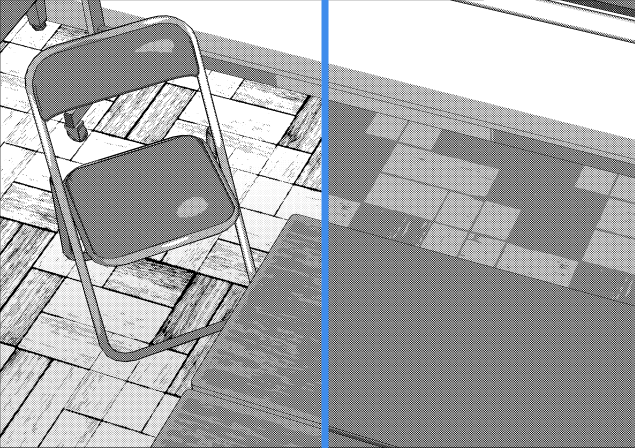Let's draw a castle in isometric
summary
Good morning. With simple settings and drawing'sub tools', you can easily draw whatever you want in isometrics. I will show you the process of drawing a castle.
Set
The canvas was created at 1750 x 1230 px, 144dpi.
First, select the'Straight Line' tool from'Sub Tool' and click'Sub Tool Settings'.
In'Unit Curve', set'Angle Unit' to 30, and activate the check box.
Hold down the'Shift' key and move the mouse based on the horizontal line to rotate by 30 degrees.
Then you are virtually ready to draw. If you need a separate isometric grid
Try this asset.
You can enlarge or reduce the size of the grid by pressing the shortcut'O'.
Planning and planning
Draw a rough shape first. Think of it as drawing a silhouette of the size you want with a line.
When drawn in a large shape, draw elements to be added in detail little by little.
I will draw on the theme of a castle made of sandstone floating in the sky.
Isometric is a good idea to draw a simple planar view of what materials to represent the front and side surfaces.
The top surface differs depending on what object you are drawing, but in most cases, even if you draw only the front and side views,
Naturally, you can get a sense of how to draw the top side.
On the left is the gate, and on the right is a rough grid of how to represent the entire wall.
sketch
Use the transform tool to similarly fit the concept drawing above to the isometric grid.
You can freely manipulate the shape with the'Parallel Transformation','Free Transformation' and'Mesh Transformation' tools.
Then, let's add a'vector layer' and finish the sketch with the straight line tool.
I initially set it with the'Parallel Ruler' tool and clicked and drew one by one, but personally, the process is very slow and inefficient, so it's easy to sketch with a straight line tool and erase unnecessary parts with a'Vector Eraser' .
If the shape is the same as the front and side, do not draw unnecessarily and simply do it with'copy, paste'.
Especially when drawing isometric, if there is an overlapping section between objects, or if you need to draw elaborately,
Add layers to avoid mistakes. Drawing on one layer is very difficult to correct.
Now let's draw the inner tower of the castle. I drew a circular tower from the rough sketch earlier.
Drawing a circle in isometric is simple.
When entering the settings in the'Sub Tool' shape, activate the check box in the'Specify vertical and horizontal' field, and set the'vertical' ratio to '0.6'.
You can draw a circle as above. Instead, it is up to you to draw elaborately.
I finished the sketch like this. Now let's move on to coloring.
coloring
First of all, you need to specify the color area. Press the'W' key to change to'auto selection'.
Select'Refer another layer' and click outside the sketched part.
After clicking, press the third time from the left on the lower display bar to activate'Reverse Selection'.
In this state, you can specify the base color and click'Fill Color'.
Pressing'Ctrl + U'brings up the setting window where you can change the'Hue/Saturation/Brightness'. From there, create the background color you want.
Then, separate the parts that will be the light side and the dark side with a coloring tool as in the image above.
Then press'Ctrl + U'and change the saturation and color a little. Increasing the saturation makes the picture fresh.
I'm going to draw a castle made of sandstone in the sun, so I turned it up.
Now let's lower the opacity of the sketched layer to some extent and paint in earnest.
I used a rough brush to express the texture of the stone.
Because it is the same tower, I did'copy, paste'. Even if you change the texture or color to each part a little here,
Each of them has a natural feeling as if they were drawn by hand.
The side of the tower was pasted into the wall.
I'm going to draw an additional waterway so that the water flows as well.
Do not draw the same elements unnecessarily in this way, and it is enough to do this one-time drawing with'copy, paste' first, and then look at the hand a little later.
Because time matters.
The original intended size of the gate has become very large, but it is different for each castle. The front of the gate also looked flat, so I drew additional stone pillars.
When coloring, it is very stable and comfortable when you need to divide and color the layer to correct it.
Isometrics seem easy, but it's not common to draw small elements within them.
After... I drew some things now, but I think it would be nice to add something like a more meticulous sculpture, so I'll add it.
I tried to draw something like an eagle, but it's not an eagle. Just think of it as some kind of bird.
It is better to draw a sculpture or something larger and resize it with'copy, paste'. That way, the picture is not damaged.
Now, while drawing the background on the back, at the same time, by adding a'multiply layer' to emphasize the dark side as a whole,
I made the effect of sunlight stand out.
Water can be drawn easily by simply using'Smudge Spray' and'Spray'.
Layer effect, finishing
The order was a little bit different, but as I said before, I emphasize the darkness more with the'multiply layer'.
Then, use the'overlay layer' to further emphasize the lighted area, and the shadows and outlines to be'multiply layer'.
Let's make up.
Then, paint the sunlight using a spray with a'luminescent dodge layer', and add some more flat areas.
End
Thank you for reading the long article. I would like to tell you about the coloring process in more detail, but I think it would be better to watch the speed painting process. Thank you.
























Comment